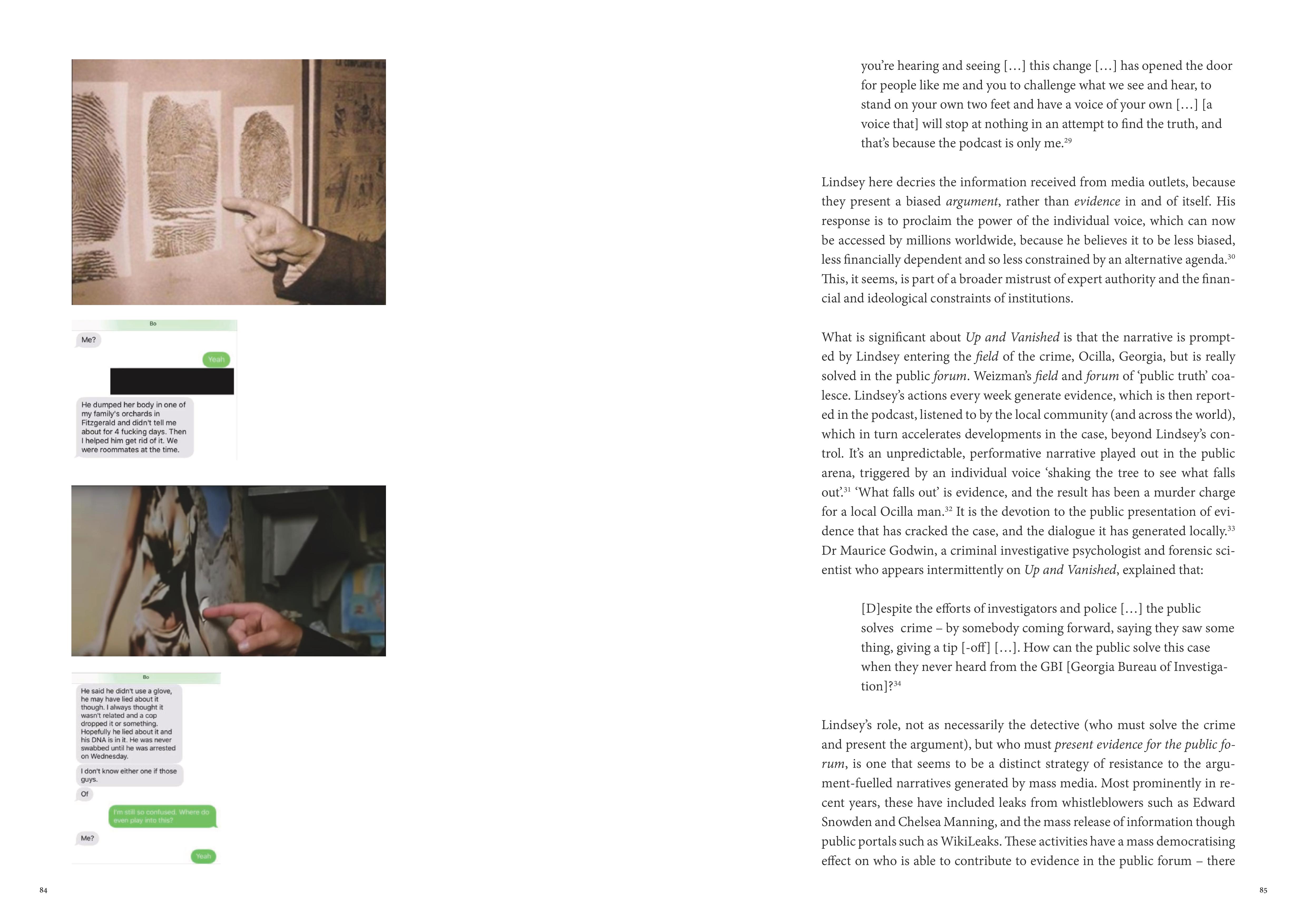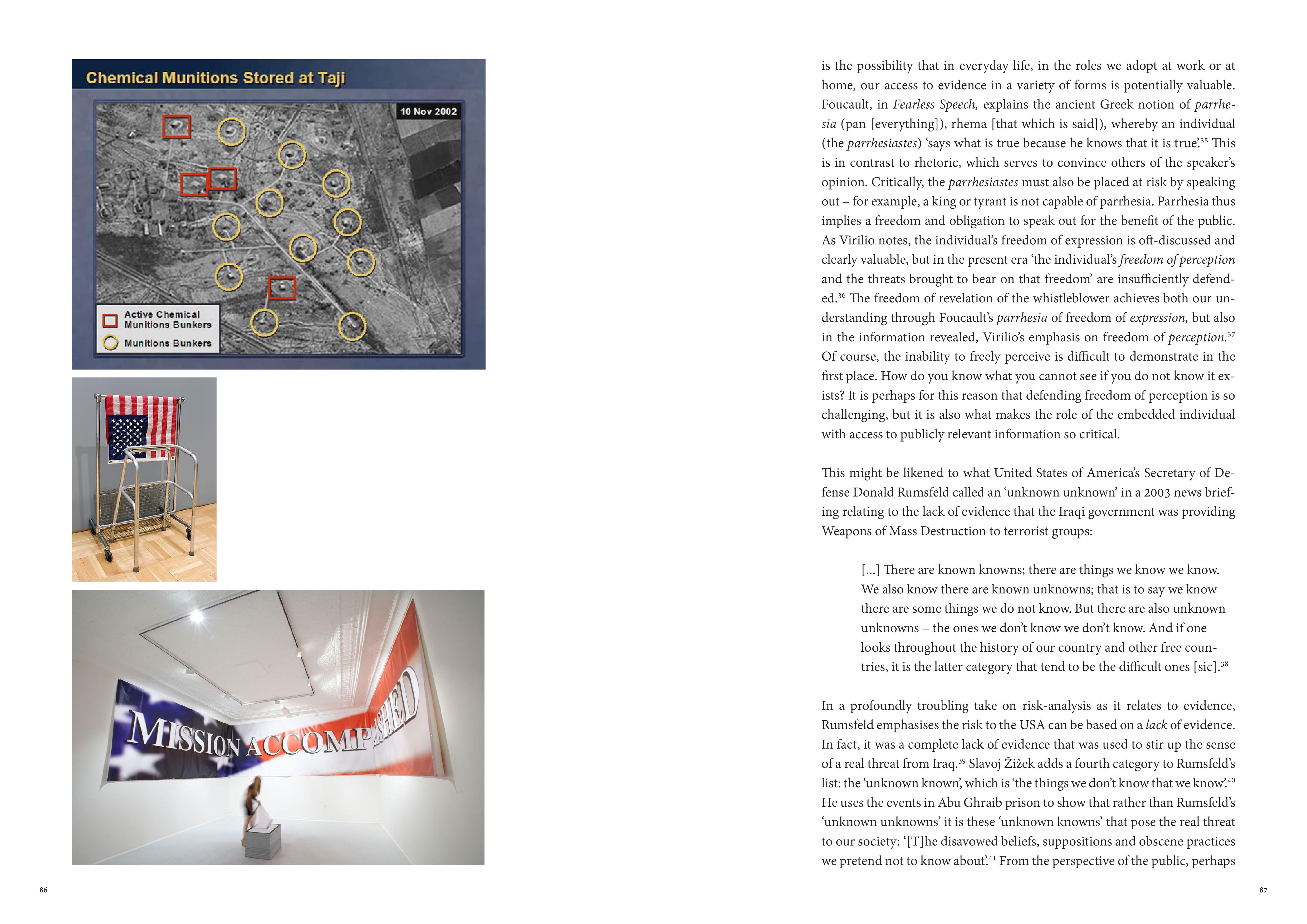A Devil in the Detail
195 pages, embossed clothbound hardcover, 2017.
Submitted for MA Fine Art dissertation at the Royal College of Art (distinction).
Full pdf available on request.

Excerpt from the introduction:
“Forensics by its contemporary definition uses science in the service of the law. As such, it appears to us as the realm of the expert, and the definitive end point of a criminal narrative, where a legal ‘truth’ is established (e.g. ‘the DNA shows x to be the culprit’). As Matthew Kirschenbaum explains, ‘Forensics itself is a Janus-faced word, by definition both the presentation of scientific evidence and the construction of a rhetorical argument’.1 However, ‘forensics’ derives from the Latin ‘forensis’, meaning, ‘Of, belonging to, or inhabiting the Forum’. The forum, also from the Latin, is a place for the public. ‘The forensic’ in its traditional sense, is, therefore, information that can act as a source of discourse to be debated by the public in a communal physical space. As Eyal Weizman notes, with this ‘telescoping’ of the term, ‘forensics’ has ‘lost its potential as a political practice’, and eradicated its relationship to the forum – ‘a multidimensional space of politics, law and economy’.2 In this dissertation, I will pan out from our contemporary notion of the ‘forensic’, because it offers an opportunity to critically analyse our understanding of what constitutes evidence, who is able, how, and where, to establish this evidence, and how it can be debated in our global ‘forum’. It also asks if the concept of ‘forensics’ can be used as a mechanism for understanding how an individual can register and respond to the institutional pressures exerted upon them in their everyday life; whether it can assist in developing a ‘responsibility’ or ‘response-ability’ i.e. the ability to respond to these lived conditions.
The text presents research into moments where historical and contemporary culture intersect with this adjusted concept of the ‘forensic’. The first chapter, ‘The Evidence: Unstable Objects’ explores how the object as a form of fixed evidence attesting to a single narrative can be undermined and replaced by a multiplicity of narratives. I consider this with reference to Alain Robbe-Grillet’s Le Voyeur and Katrina Palmer’s The Dark Object, alongside O.J. Simpson’s glove which proved central to his 1994 murder trial. I then go on to ask how this can be applied in pursuit of sociopolitical upheaval, through the ideologies of the Surrealists, the Situationists, Gordon Matta-Clark, Critical Art Ensemble and with an example of passive resistance from Herman Melville’s Bartleby, The Scrivener. The second chapter, ‘The Crime Scene: Traces and Boundaries’, connects the model of the crime scene as a site of investigation to Georges Perec’s An Attempt at Exhausting a Place in Paris and Henri Lefebvre’s Rhythmanalysis. Through Walter Benjamin’s understanding of the ongoing historical ‘catastrophe’, it explores the sociopolitical motivations and implications of these forensic practices applied to the everyday. I argue that the enforced boundaries of the crime scene can be used to understand acts of resistance and production in the arena of daily life. The third chapter, ‘The Detective: An Amateur and The Expert’ explores the role of the layman, or amateur, in establishing and negotiating ‘public truth’. I consider this with reference to some approaches of the research group Forensic Architecture, which are compared to those of the artist Trevor Paglen, the podcaster Payne Lindsey and select whistleblowers. The fourth chapter, ‘The Investigation: Experience to Challenge Encounter’ asks which strategies of investigation can be used in an era dominated by speed and superficial exposure and whether a slow, durational experience of forensic investigation can provide at least a partial grounding for resistance.”
1 Matthew G. Kirschenbaum, Mechanisms: New Media and the Forensic Imagination (Cambridge, MA; London: MIT Press, 2008), p. 21.
2 Eyal Weizman, ‘Introduction: Forensis’, in Forensis: The Architecture of Public Truth, ed. by Eyal Weizman (Berlin: Sternberg Press, 2014), p. 9.
Sample spreads:

